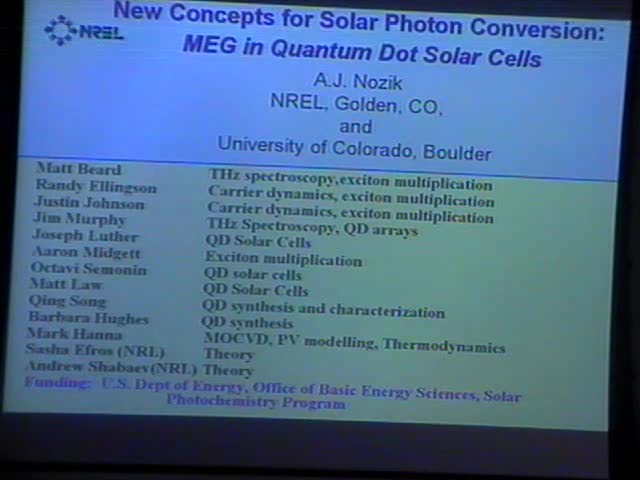Multiple exciton generation in semiconductor quantum dots and novel molecules: Applications to third generation solar photon conversion
Presenter
November 1, 2008
Keywords:
- Semiconductor
MSC:
- 82D37
Abstract
In order to utilize solar power for the production of electricity and fuel on a massive scale, it will be necessary to develop solar photon conversion systems that have an appropriate combination of high efficiency (delivered watts/m2) and low capital cost ($/m2) to produce solar power that is competitive with coal. One potential, long-term approach to high efficiency is to utilize the unique properties of quantum dot nanostructures to control the relaxation dynamics of photogenerated carriers to produce either enhanced photocurrent through efficient photogenerated electron-hole pair multiplication or enhanced photopotential through hot electron transport and transfer processes. To achieve these desirable effects it is necessary to understand and control the dynamics of hot electron and hole relaxation, cooling, charge transport, and interfacial charge transfer of the photogenerated carriers with femtosecond (fs) to ns time resolution. At NREL, we have been studying these fundamental dynamics in various bulk and nanoscale semiconductors (quantum dots (QDs), quantum rods/wires, and quantum wells) for many years using fs transient absorption, photoluminescence, and THz spectroscopy. Recently, we predicted that the generation of more than one electron-hole pair (existing as excitons in QDs) per absorbed photon would be an efficient process in QDs . This prediction has been confirmed over the past several years in several classes of QDs. We have observed very efficient and ultrafast multiple exciton generation (MEG) from absorbed single high energy photons in Group IV-VI and recently in Si QDs. Efficient MEG has the potential to greatly enhance the conversion efficiency of solar cells that incorporate QDs for both solar.
